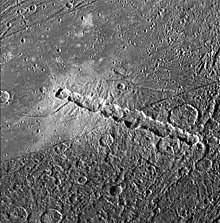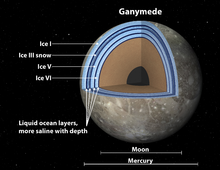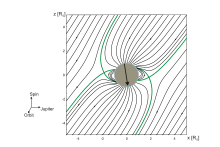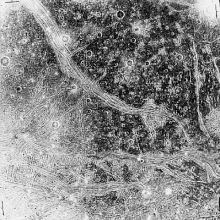Ganymede (moon)
| Ganymede | |
|---|---|

|
|
| Jupiter's moon Ganymede, imaged by the Galileo spacecraft on June 26, 1996 | |
| Central body | Jupiter |
| Properties of the orbit | |
| Major semi-axis | 1,070,400 km |
| Periapsis | 1,069,300 km |
| Apoapsis | 1,071,500 km |
| eccentricity | 0.001 |
| Orbit inclination | 0.18 ° |
| Orbital time | 7.155 d |
| Mean orbital velocity | 10.88 km / s |
| Physical Properties | |
| Albedo | 0.44 |
| Apparent brightness | 4.6 likes |
| Medium diameter | 5262.4 km |
| Dimensions | 1.4819 x 10 23 kg |
| Medium density | 1.940 g / cm 3 |
| Sidereal rotation | 7.155 d |
| Axis inclination | 0 ° |
| Acceleration of gravity on the surface | 1.42 m / s 2 |
| Escape speed | 2700 m / s |
| Surface temperature | 70 - 110 - 152 K |
| discovery | |
| Explorer | |
| Date of discovery | January 7, 1610 |
| Remarks | Simply bound rotation |

|
|
| Size comparison between Ganymede (bottom left), Earth's moon (top left) and Earth (true-to-scale photomontage) | |
Ganymede (also Jupiter III ) is the third and largest of the four Galilean moons of the gas planet Jupiter . With a diameter of 5262 km, it is the largest moon in the solar system . Like Saturn's moon Titan , it has a slightly larger diameter than the (albeit more massive) planet Mercury .
Ganymede belongs to the ice moons type and has an iron core . It is the only satellite with a strong magnetic field and has a very thin atmosphere .
discovery
Ganymede's discovery is attributed to the Italian scholar Galileo Galilei , who pointed his simple telescope at Jupiter in 1610 . The four moons Io , Europa , Ganymede and Callisto are therefore also referred to as the Galilean moons.
The moon was named after the young man Ganymede , a cupbearer of the gods and lover of Zeus from Greek mythology . It is the only moon of Jupiter that is named after a male figure. Although the name Ganymede had been suggested by Simon Marius shortly after its discovery , it was not accepted for a long time. It was not used again until the middle of the 20th century. Previously, the Galilean moons were usually denoted with Roman numerals and Ganymede was Jupiter's moon III. Unlike the Earth's moon , Ganymede, like all satellites in the solar system, has no official astronomical symbol or one that is commonly used.
The Galilean moons are so bright that you can see them with binoculars . With a brightness of up to 4.6 mag, Ganymede in particular is so bright during opposition times that it would be freely visible if it were not outshone by nearby Jupiter.
Orbit and rotation
Ganymede orbits Jupiter at a mean distance of 1,070,400 km in 7 days, 3 hours and 42.6 minutes. It is thus in resonance with its two inner neighbors Europe (1: 2) and Io (1: 4), an effect that contributes to the relatively large eccentricities of the orbits of these moons. It is of great importance for the tidal friction inside these moons and is therefore an explanation for the volcanism on Io . Ganymede's orbit has an eccentricity of 0.0015 and is only 0.21 ° inclined to Jupiter's equatorial plane.
Ganymede rotates around its own axis in 7 days, 3 hours and 42.6 minutes and, like the Earth's moon and the other inner moons of Jupiter, shows a bound rotation . Because of its low orbital eccentricity compared to the Earth's moon and the very small inclination of the axis, libration effects are low. The maximum libration of the length, which is proportional to the eccentricity, is only about 10 ′ (about 7 ° for the earth's moon). The tidal effects caused by this tumbling movement, which are considered to be the main cause of the strong volcanism at Io, are therefore much smaller (also because of the much greater distance).
Physical Properties
Ganymede has a mean diameter of 5262 km, making it the largest moon in the solar system . It is slightly larger than Saturn's moon Titan (5150 km) and significantly larger than the planet Mercury (4878 km), although with its low density of 1.936 g / cm 3 it has only 45% of Mercury's mass.
surface
Ganymede's surface, which consists of ice hundreds of kilometers thick, can be divided into two different areas: a geologically very old, dark region with a large number of impact craters and a somewhat younger, lighter region with less crater density but with pronounced rifts and faults . The two regions are due to tectonic activities.
Ganymede's surface consists of two continental plates that move independently of one another, with flat mountain ranges being thrown up on their fringes . In addition, areas are visible through which so-called watery lava could have flowed, the origin of which can be traced back to past cryovolcanism . In terms of tectonics, Ganymede is similar to planet Earth , although activities on Ganymede have come to a standstill. The dark regions resemble the surface of Callisto; a similar system of rifts and faults exists on Saturn's moon Enceladus and the Uranus moons Miranda and Ariel .
Both regions have many impact craters; their number and distribution give Ganymede's surface an age of 3 to 3.5 billion years, comparable to the Earth's moon . The craters overlay the trenches or are broken by them, which suggests that the trenches are also geologically old. There are also recent impacts in which material was ejected from the underground in the form of radiation systems . In contrast to the Earth's moon or Mercury, most of the craters are relatively flat and have no ring walls or central mountains . Obviously the ice crust has given way over geological time and leveled these structures. Very old craters can only be seen as dark reliefs . By far the largest named crater named Epigeus has a diameter of 343 km and is located on the central meridian of the hemisphere facing away from Jupiter, between the dark regions Galileo Regio and Marius Regio .
The largest contiguous structure on Ganymede is the dark Galileo Regio plain . With a diameter of 3,200 km, it covers a third of the hemisphere turned away from Jupiter and can sometimes be seen from Earth in large telescopes. The plain is extremely rich in craters and traversed by bright stripes; It probably represents the oldest surface of the moon. Furthermore, extensive concentric elevations are visible on Ganymede, which are the remnants of a huge impact event from the early days of the moon.
An unusual structure in planetary geology is the Thiamat Sulcus , an almost 2,000 km long band of furrowed terrain near the equator between Marius Regio and Melotte Regio , which is interrupted by a fault. To the north of this the sulcus has 14 parallel furrows, but to the south it has 20, which can be explained by fracture tectonics of different periods of time.
Ganymede's albedo is 0.43, which means that 43% of the incident sunlight is reflected from the surface. Compared to the moons Io and Europa, its surface is relatively dark. The average surface temperature is −160 ° C.
internal structure
The analysis of the data from the Galileo space probe indicated that Ganymede is a differentiated body with a shell structure . A relatively small core made of iron or iron sulfide is surrounded by a mantle of silicate rock . Above it is a slightly salty ocean that could contain more water than all of the world's oceans combined. The outermost layer is a hard water ice crust.
According to a new model, crystals of a denser type of ice form in the lower area of the ice crust. The contained salts are released and sink to the bottom, where they form a lower, more salty part of the ocean with water. It floats on another layer of an even denser type of ice, and such a layering of liquid water and ice could be repeated several times. From the outermost ice surface to the stony "ocean floor" it is about 800 km depth.
Furthermore, the orbital movement of the Galileo space probe showed small anomalies in the gravitational field , which either indicate an uneven rock cover or indicate larger amounts of rocks enclosed in the ice cover. Perhaps they are also caused by rock debris in shallow ice layers.
The metallic core is an indication that Ganymede had higher temperatures inside than had previously been assumed in the early days of its formation. In fact, Ganymede seems to have a similar structure to Io, only that it is also surrounded by water and ice.
the atmosphere
The first signs of the existence of an atmosphere around Jupiter's moon were found back in 1972 when Ganymede covered the star SAO 186800. The pressure in the extremely thin atmosphere was stated to be greater than 10 −6 bar at that time . Observations with the Hubble Space Telescope in 1997 revealed evidence of an extremely thin atmosphere of oxygen . It is assumed that the oxygen is created by the action of solar radiation on the ice crust, whereby the water ice is split into oxygen and hydrogen . The volatile hydrogen escapes into space, the more massive oxygen is held in place by Ganymede's gravity .
Magnetic field
During the first two flybys of the space probe Galileo on the moon Ganymede in June 1996 (G1) at an altitude of 838 km and in September 1996 (G2) at an altitude of only 264 km, it was possible to prove that Ganymede has its own magnetic dipole field . In addition to Earth and Mercury , Ganymede is the only solid planetary body in the solar system with its own dipole field, in particular the only moon. However, speculations about such a field of Jupiter's moon Io have not been confirmed.
In a first approximation, the magnetic field can be assumed to be a simple superposition of a dipole field with the field of Jupiter in a vacuum. The Jupiter field can be viewed in an environment of the moon from about 10 Ganymedradien be constant thereby, the strength of this homogeneous field about 120 n T is. The orientation of the magnetic field can, however, vary during the orbit around Jupiter. The model fits the data of the flyby G1 if an equatorial field strength of the dipole field of 750 nT is assumed (shown in the adjacent picture). The field strength is much lower than that of the earth's magnetic field (equatorial 30,000 nT), but greater than that of the planet Mercury (equatorial 450 nT). The direction of the magnetic dipole deviates about 10 ° from the axis of rotation and points in the Ganymede-centered coordinate system in the direction of the 220th degree of longitude (the prime meridian always points to Jupiter because of the bound rotation).
The structure of the magnetic field is somewhat different from the planetary magnetic fields of the earth or the gas planets . The surrounding magnetic field of Jupiter is so strong that there is only a relatively small zone on the surface of Ganymede at the equator, where the magnetic field lines from the moon run back to the moon. In the relatively large polar regions, however, the field lines run to Jupiter or come from there. The green line in the adjacent picture - the "Separatrix" - separates areas in which the field lines run from Ganymede to Ganymede, Ganymede to Jupiter and from Jupiter to Jupiter.
Better models of the magnetic field take into account the fact that Ganymede does not move in a vacuum through Jupiter's magnetic field, but that there is a plasma corotating with Jupiter in which the moon is located (bilateral rotational bond). The inclusion of the plasma in the model takes place within the framework of magnetohydrodynamics and explains the formation of a magnetosphere . The existence of a magnetopause was confirmed by Galileo, but in contrast to the Earth's magnetosphere, there is no bow shock wave . To form such a shock wave, the inflowing plasma would have to have a speed relative to Ganymede that is greater than the Alfvén speed . In contrast to Earth, where the solar wind hits the magnetopause at about eight times the speed of Alfvén (and ten times the speed of sound ), the corotating plasma of Jupiter has 2.4 times the speed of sound, but only about half the speed of Alfvén. In the polar regions of Ganymede, in which field lines run from Jupiter to Ganymede, plasma can penetrate to the planet's atmosphere, where it leads to auroras , which the Hubble Space Telescope could actually observe in UV light.
The fact that the direction of the dipole deviates from the direction of the axis of rotation by only 10 ° suggests that the cause of the magnetic field is to be found in a dynamo effect. Conductive liquids are a possible carrier of the dynamo effect. Both liquid metal in the core of the moon and salt water in the mantle are discussed as candidates.
Exploration through probe missions

Spacecraft exploration of Ganymede began in 1973 and 1974 with the Jupiter flybys of Pioneer 10 and Pioneer 11 . In 1979 Voyager 1 and Voyager 2 were able to make more precise observations of this moon for the first time. Most of what we know about Ganymede, however, comes from the Galileo orbiter, which reached the Jupiter system in 1995 and made several close flybys over Jupiter's moon over the next eight years.
For 2020, the space agencies NASA and ESA had proposed the joint Europa Jupiter System Mission Laplace, which provided for at least two orbiters, each of which would enter an orbit around Europa and Ganymede and should explore the entire Jupiter system with a revolutionary depth.
However, NASA, which wanted to build the Jupiter Europa Orbiter (JEO), withdrew from the project. However, ESA realizes the Jupiter Ganymede Orbiter (JGO) with a slightly modified mission plan as JUICE . After arriving at Jupiter in 2030, JUICE is expected to enter an orbit around Ganymede in 2032 after two flybys of Europe and twelve flybys of Kallisto. Since the NASA probe is no longer needed, the Europe flybys have been included in the JUICE mission plan as a replacement.
Cultural history
Ganymede is the setting in the plot of novels, short stories, television series or films. An incomplete selection:
- The novel Farmer in the Sky ( English Farmer in the Sky , 1950) by Robert A. Heinlein is about terraforming and the settlement of Ganymede.
- Ganymede plays an essential role in many of Philip K. Dick's novels and short stories . The moon is most prominently represented in the novel The Ganymede Takeover ("The Invaders of Ganymede"), which was written in 1967 with Ray Nelson .
- The 1977 German feature film Operation Ganymede is about the experiences of a fictional spaceship crew who are returning to earth from a trip to Ganymede .
- In the television series Babylon 5 (1996), a ship of the "Shadows" was discovered beneath the surface of Ganymede and destroyed by a "Whitestar" ship.
- In the anime series Cowboy Bebop (1998), the moon is the birthplace of the character Jet Black.
- In the Giants series by James P. Hogan , Ganymede appears in Book 2, which is about a group of extraterrestrials who work with terrestrial scientists to investigate the strange story of an earlier epoch of the solar system.
- The British-American scientist and science fiction author Charles Sheffield placed in the book series The Dark Universe (1992-2002) the plot on Ganymede and the other Galilean moons. It comprises three books, which are also available in German.
- In the novel and television series The Expanse by James Corey , Ganymede is a populated moon and the breadbasket of the outer solar system. In the 2nd book, Caliban's War , Ganymede is the main scene of the plot.
- In the board game "Ganymede" the player recruits settlers on earth in order to let them set off with ships on the Ganymede to conquer space.
Web links
-
The
nine8 planets: Ganymede. At: nineplaneten.de . - Chr. Pinter: Trapped in the eternal ice age. ( Memento of November 24, 2005 in the Internet Archive ). In: wienerzeitung.at . December 13, 2002.
- Global Geologic Map of Ganymede. USGS Scientific Investigations Map 3237. At: usgs.gov. Retrieved February 14, 2014.
- scinexx .de: sandwich structure and "upward snow" May 5, 2014
- scinexx.de: Riddle of the Northern Lights solved May 2nd, 2018
Individual evidence
- ↑ a b NASA Jovian Satellites Fact Sheet. Vestibules, path speed, surface and brightness are calculated from this.
- ^ P. Schenk, J. Moore: Volcanic constructs on Ganymede and Enceladus: Topographic evidence from stereo images and photoclinometry . In: J. Geophys. Res. . 100 (E9), 1995, pp. 19009-19022.
- ↑ P. Schenk, W. McKinnon, D. Gwynn, J. Moore: looding of Ganymede's resurfaced terrains by low-viscosity aqueous lavas . In: Nature . 410, 2001, pp. 57-60.
- ↑ Ganymedkrater in the Gazetteer of Planetary Nomenclature of the IAU (WGPSN) / USGS ; last accessed on September 24, 2016.
- ^ Whitney Clavin: Ganymede May Harbor 'Club Sandwich' of Oceans and Ice. In: jpl.nasa.gov. May 1, 2014, accessed May 5, 2014.
- ↑ RW Carlson et al.: An Atmosphere on Ganymede from Its Occultation of SAO 186800 on June 7, 1972. At: ScienceMag.org. October 5, 1973, Vol. 182, No. 4107, pp. 53-55.
- ^ Ganymede page . In: nineplanets.org. October 31, 1997, accessed March 11, 2008 .
- ↑ a b M. G. Kivelson et al: Discovery of Ganymede's magnetic field by the Galileo spacecraft. At: Nature.com. December 12, 1996. Volume 384, pp. 537-541.
- ↑ KK Khurana et al: Io's Magnetic Field. EGS XXVII General Assembly, Nice, 21. – 26. April 2002, bibcode : 2002EGSGA..27.5119K
- ↑ SM Stone: Investigation of the magnetosphere of Ganymede with Galileo's energetic particle detector . University of Kansas 2001, ISBN 978-0-599-86357-6 (dissertation, 563 pages).
- ^ DT Hall, PD Feldman, MA Mcgrath, DF Strobel: The Far-Ultraviolet Oxygen Airglow of Europa and Ganymede. 1998, ApJ, 499, 475.
- ^ G. Schubert et al .: Magnetic fields and internal structures of Ganymede. Nature, 384, 544, 1996.
- ^ Exploring the emergence of habitable worlds around gas giants. JUICE Assessment Study Report, December 2011 (Yellow Book), accessed on September 9, 2012 (PDF; 39.7 MB).
| before | Jupiter moons | after that |
| Europe |
(largest moon in the solar system) |
Callisto |




